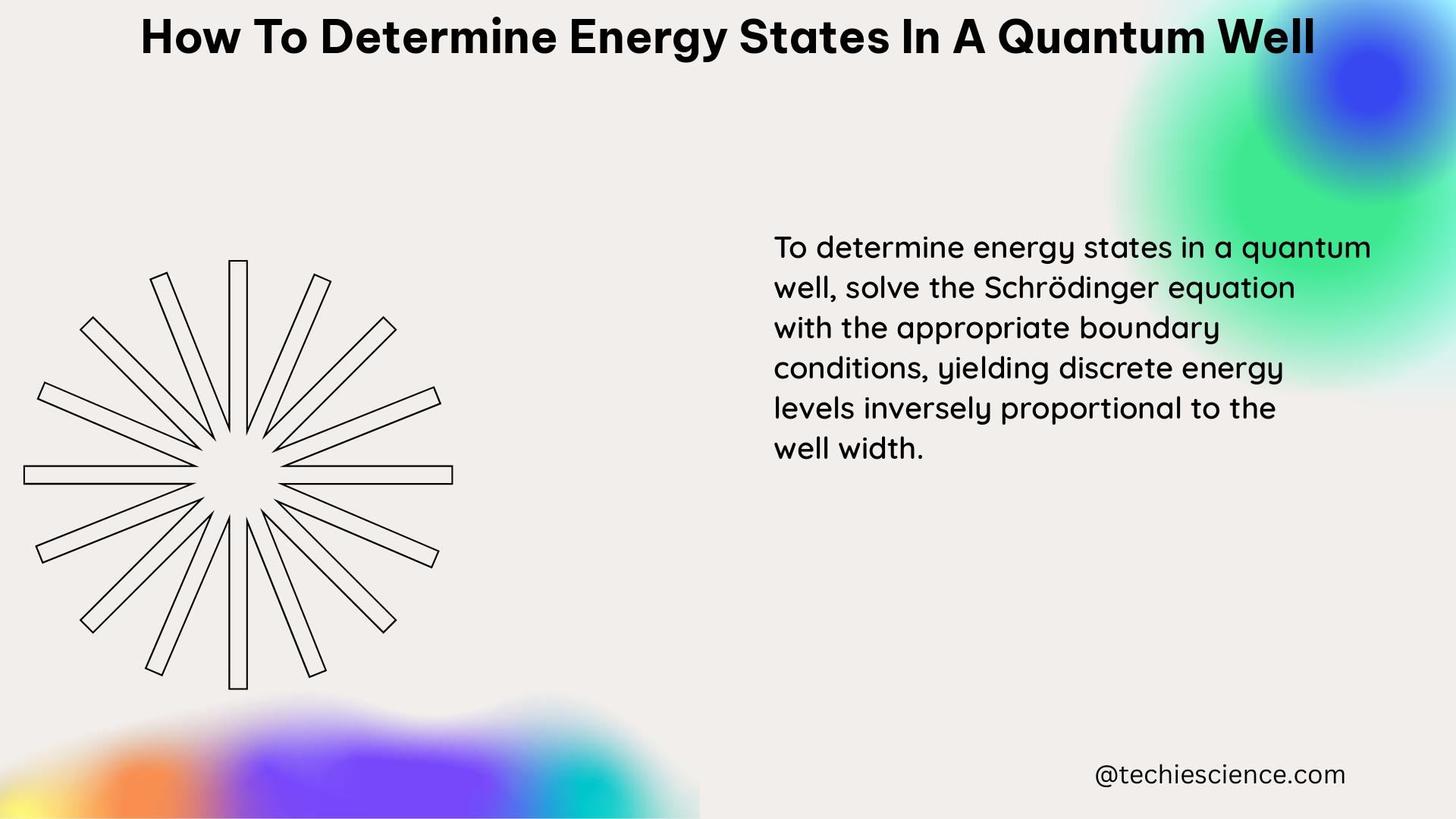Determining the energy states in a quantum well is a fundamental concept in quantum mechanics, with applications in various fields, including semiconductor physics, nanotechnology, and quantum computing. This comprehensive guide will walk you through the step-by-step process of solving the Schrödinger equation to find the energy levels and wave functions in a quantum well.
Defining the Potential Well
The first step in determining the energy states in a quantum well is to define the potential well. In the simplest case, the quantum well is modeled as a one-dimensional rectangular potential well with infinite barriers at the edges. This means that the potential energy inside the well is zero, and it becomes infinitely large outside the well.
Mathematically, the potential energy function, V(x), for a rectangular potential well can be expressed as:
V(x) = {
0, for 0 ≤ x ≤ L
∞, for x < 0 and x > L
}
where L is the width of the well.
Solving the Schrödinger Equation

The next step is to solve the time-independent Schrödinger equation for the quantum well system. The Schrödinger equation is a fundamental equation in quantum mechanics that describes the behavior of a particle in a potential field. The time-independent Schrödinger equation for a one-dimensional potential well is given by:
Hψ(x) = Eψ(x)
where:
– H is the Hamiltonian operator
– ψ(x) is the wave function of the particle
– E is the energy of the particle
For the rectangular potential well, the Schrödinger equation can be solved analytically, and the solutions for the energy levels are given by:
E_n = (h^2 π^2 n^2) / (2mL^2)
where:
– h is the Planck constant
– m is the mass of the particle
– n is an integer that labels the energy levels (n = 1, 2, 3, …)
This equation shows that the energy levels in a quantum well are quantized, meaning they can only take on discrete values. The energy levels are inversely proportional to the square of the well width, L, and proportional to the square of the integer n.
Calculating the Wave Functions
Once the energy levels are known, the next step is to calculate the wave functions, ψ(x), for each energy level. The wave functions for a rectangular potential well are given by:
ψ_n(x) = √(2/L) sin(nπx/L)
where x is the position of the particle within the well.
The wave functions represent the probability distribution of the particle within the well and are essential for understanding the quantum mechanical behavior of the system.
Experimental Determination of Energy States
In addition to the theoretical approach, the energy states in a quantum well can also be determined experimentally using various measurement techniques, such as:
-
Optical Spectroscopy: By measuring the absorption or emission spectrum of a quantum well, the positions of the peaks in the spectrum can be used to determine the energy levels of the system.
-
Scanning Tunneling Microscopy (STM): STM can be used to directly measure the local density of states in a quantum well, which is related to the energy levels of the system.
-
Transport Measurements: Electrical transport measurements, such as current-voltage characteristics or capacitance-voltage measurements, can provide information about the energy levels in a quantum well.
These experimental techniques can be used to validate the theoretical predictions and provide a deeper understanding of the quantum well system.
Practical Examples and Applications
The determination of energy states in quantum wells has numerous practical applications, including:
-
Semiconductor Devices: Quantum wells are widely used in semiconductor devices, such as quantum well lasers, quantum well infrared photodetectors, and quantum well transistors, where the energy levels play a crucial role in the device performance.
-
Quantum Computing: Quantum wells can be used to confine electrons or excitons (electron-hole pairs) in a two-dimensional system, which is essential for the development of quantum computing and quantum information processing devices.
-
Nanoscale Devices: Quantum wells are also used in the fabrication of nanoscale devices, such as quantum dot solar cells and quantum well-based sensors, where the precise control of energy levels is crucial for optimizing device performance.
-
Fundamental Research: The study of energy states in quantum wells provides valuable insights into the fundamental principles of quantum mechanics and the behavior of particles in confined systems.
Conclusion
Determining the energy states in a quantum well is a crucial step in understanding the quantum mechanical behavior of particles in confined systems. By solving the Schrödinger equation and calculating the energy levels and wave functions, researchers and engineers can design and optimize a wide range of quantum-based devices and technologies. This comprehensive guide has provided you with the necessary theoretical and practical knowledge to tackle the problem of determining energy states in a quantum well.
References
- Wikipedia article on measurement in quantum mechanics: https://en.wikipedia.org/wiki/Measurement_in_quantum_mechanics
- nextnano tutorial on double quantum wells: https://www.nextnano.com/documentation/tools/nextnanoplus/tutorials/1D_double_qw.html
- webassign.net lab manual for quantum states in the visible hydrogen atomic emission spectrum: https://www.webassign.net/labsgraceperiod/ucscgencheml1/lab_6/manual.html

The lambdageeks.com Core SME Team is a group of experienced subject matter experts from diverse scientific and technical fields including Physics, Chemistry, Technology,Electronics & Electrical Engineering, Automotive, Mechanical Engineering. Our team collaborates to create high-quality, well-researched articles on a wide range of science and technology topics for the lambdageeks.com website.
All Our Senior SME are having more than 7 Years of experience in the respective fields . They are either Working Industry Professionals or assocaited With different Universities. Refer Our Authors Page to get to know About our Core SMEs.